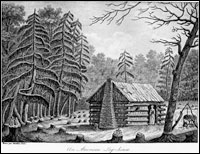Campus Martius Museum [OH]
The Campus Martius Museum highlights migration in Ohio's history. The museum is on the site of the fortification built by the Ohio Company of Associates, as their headquarters, in 1788 when they founded the first organized American settlement in the Northwest Territory. The restored Rufus Putnam house, part of the original fort, is now enclosed within a wing of the museum. Behind the museum is the Ohio Company's Land Office. Exhibits on the main floor of the museum focus on the early settlement of Marietta and Ohio and contain many of the original pioneer artifacts. The exhibits also explore the prehistoric Indian populations that occupied this area and relations with the historic Indians as the white settlers moved in. Other areas explore such topics as surveying of the land, early government in the old Northwest Territory, and life in early Marietta. A separate area exhibits a variety of material from the Marietta area down through the years, from items of household furnishings, to toys, to tools, to fire prevention equipment.
The museum offers exhibits, tours, and workshops and other educational programs.
